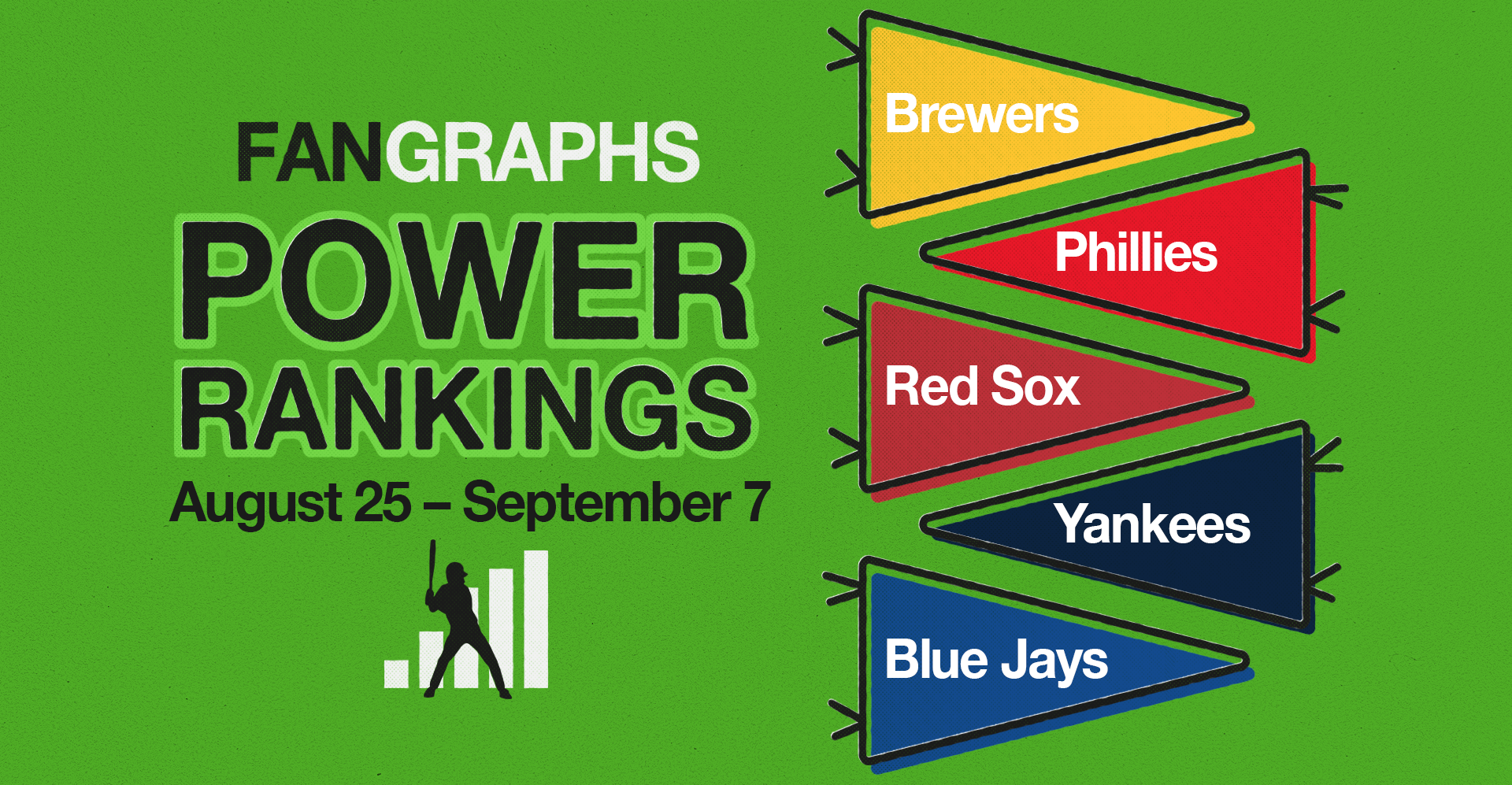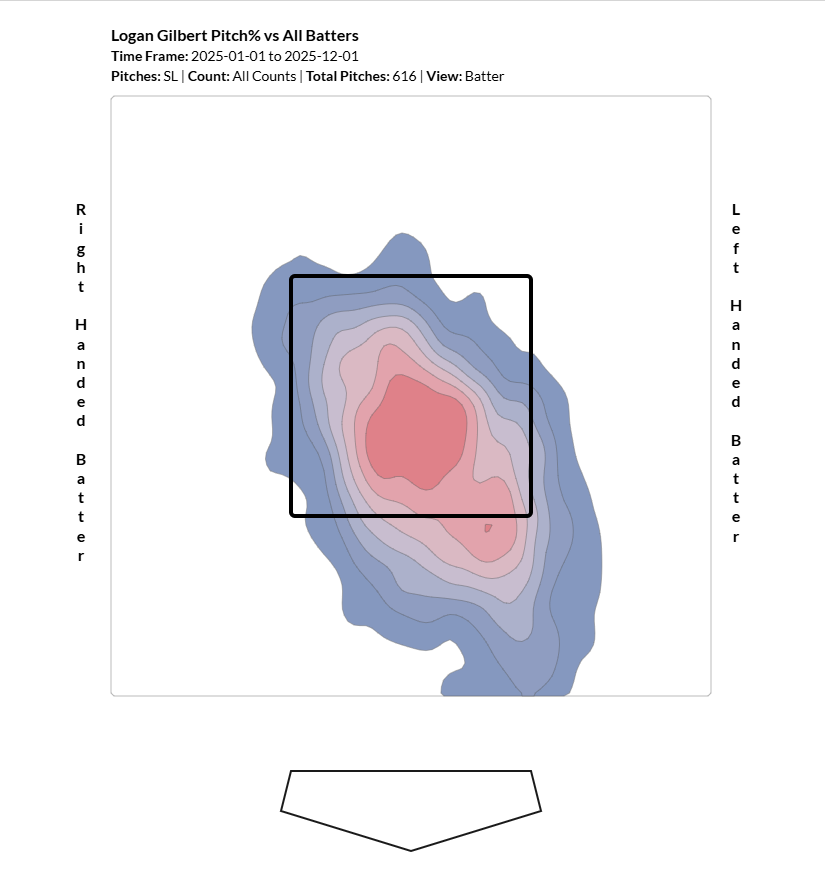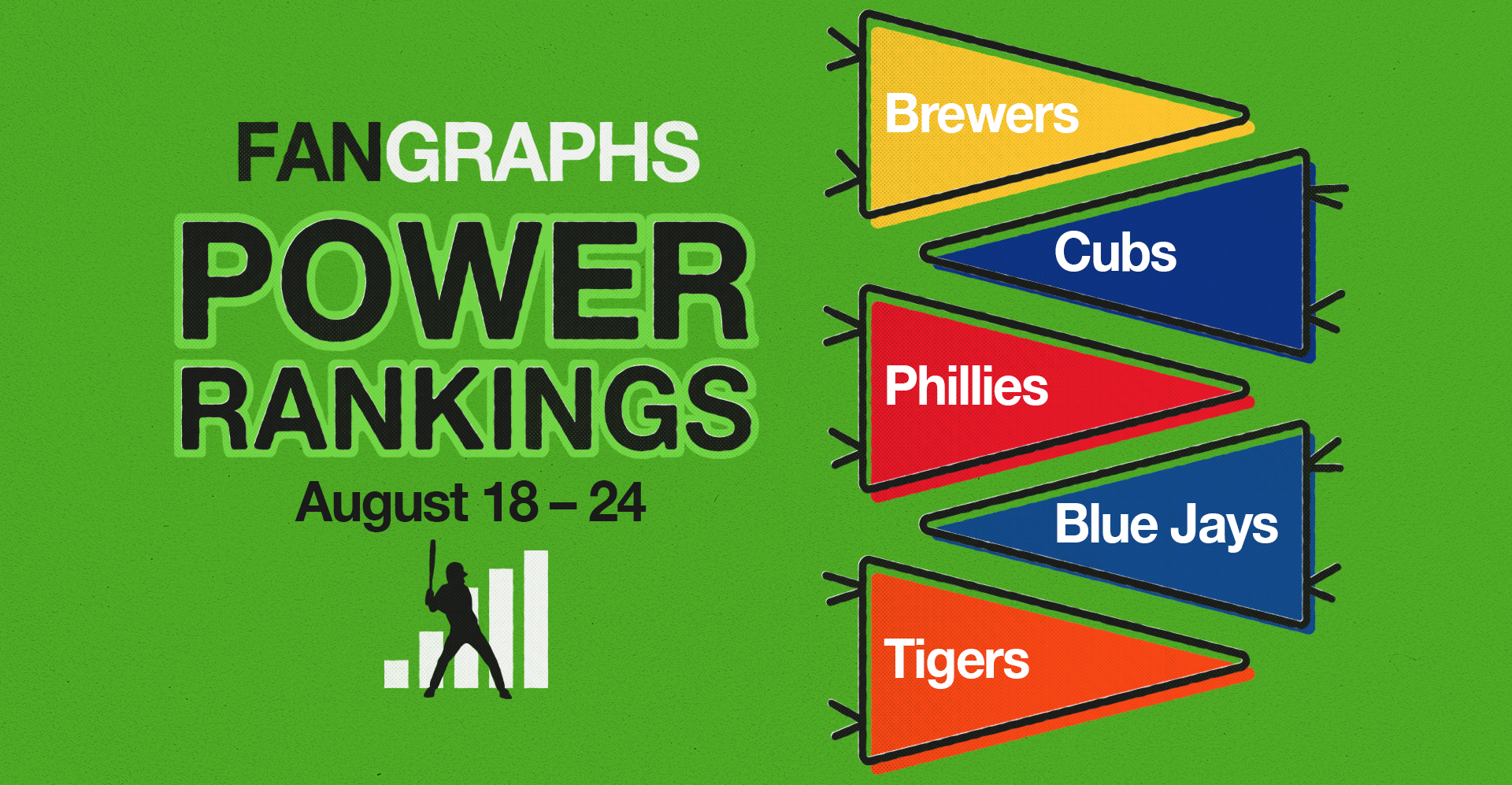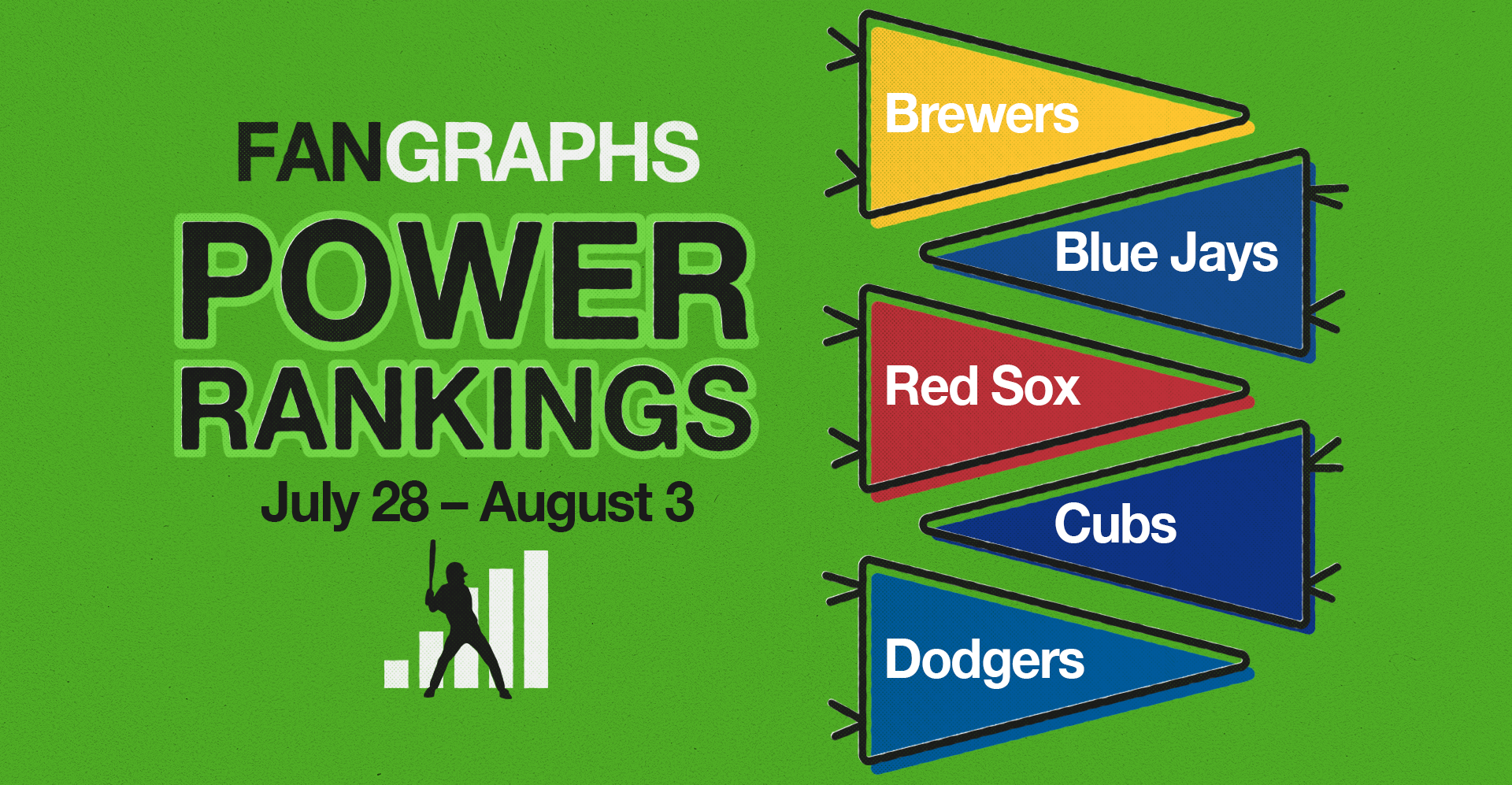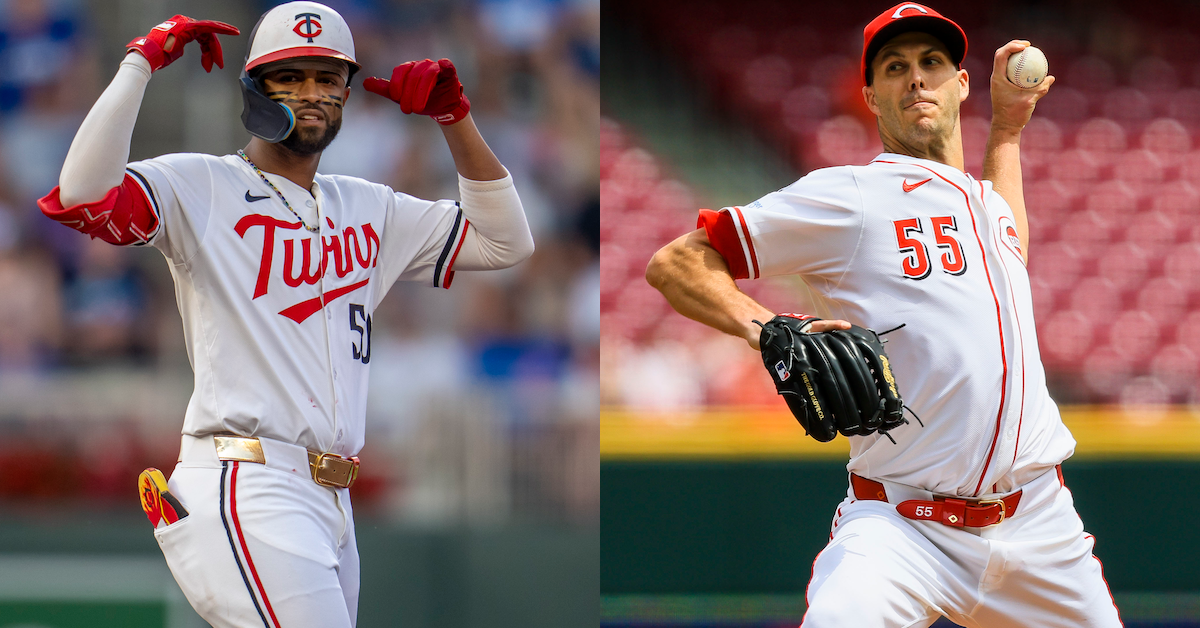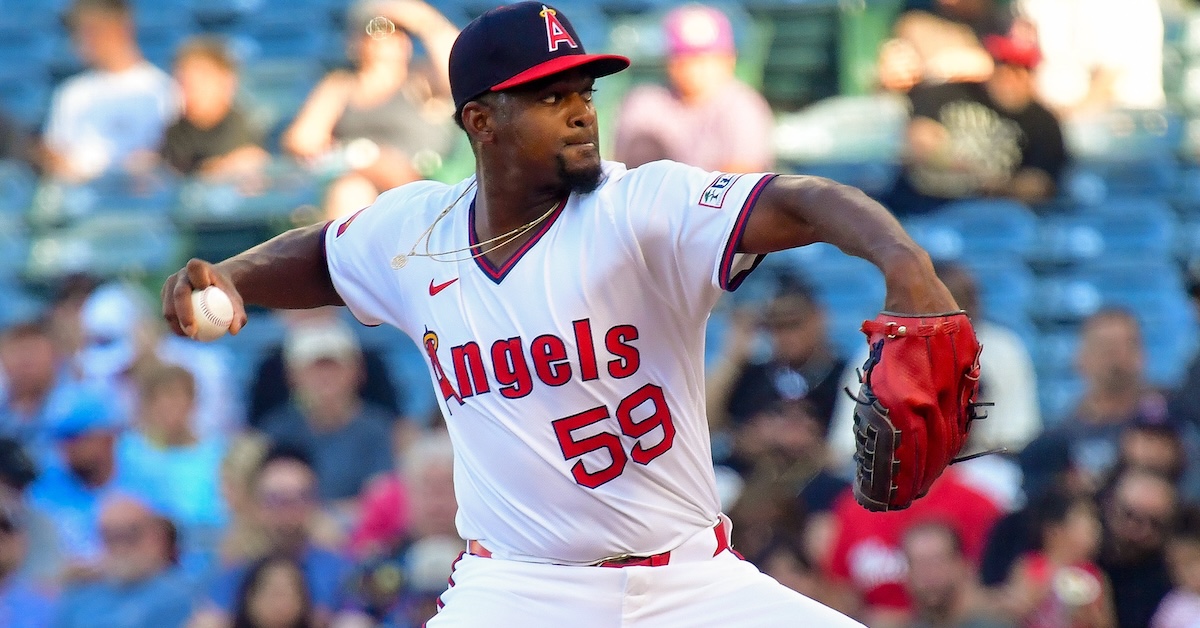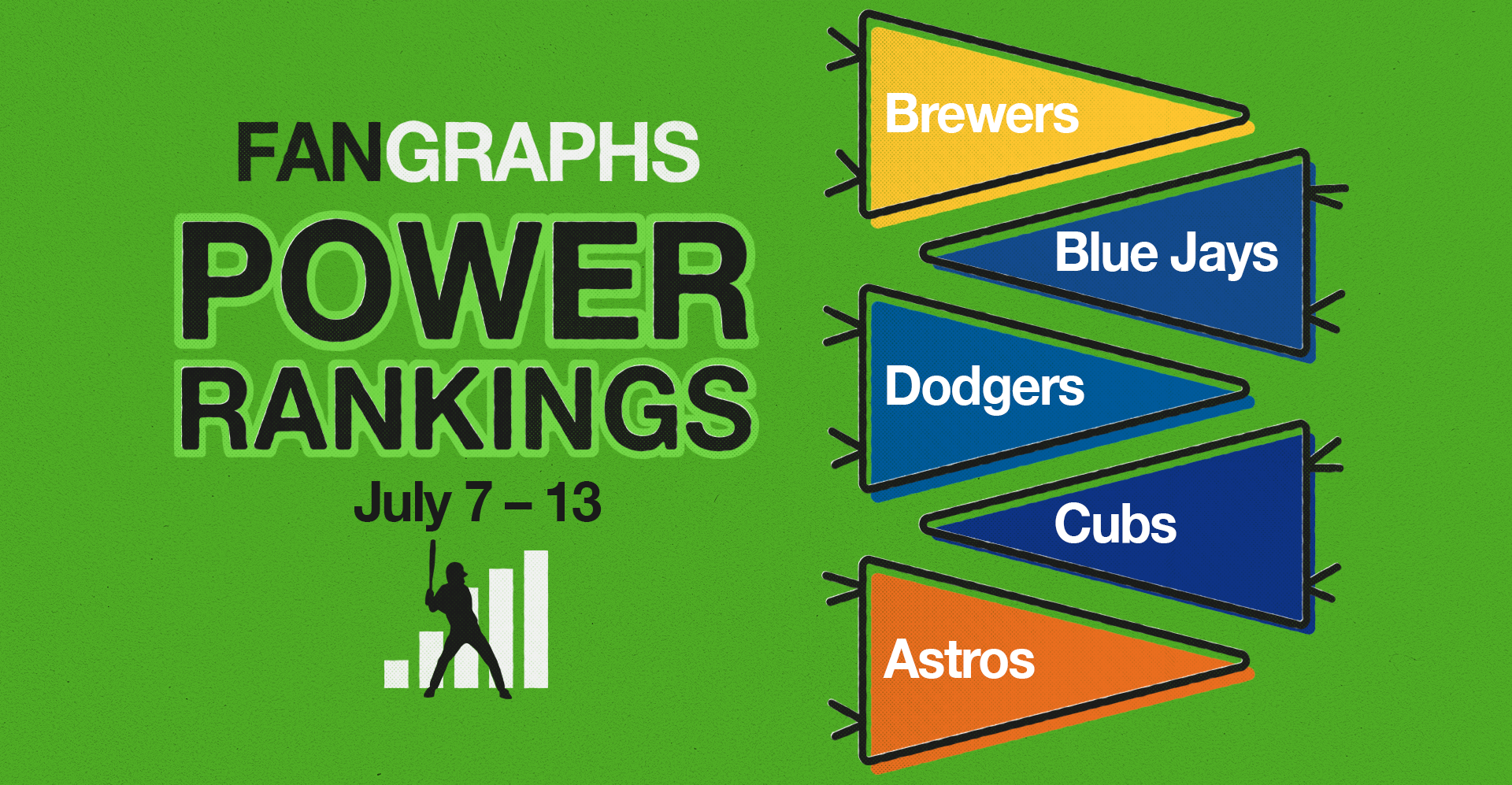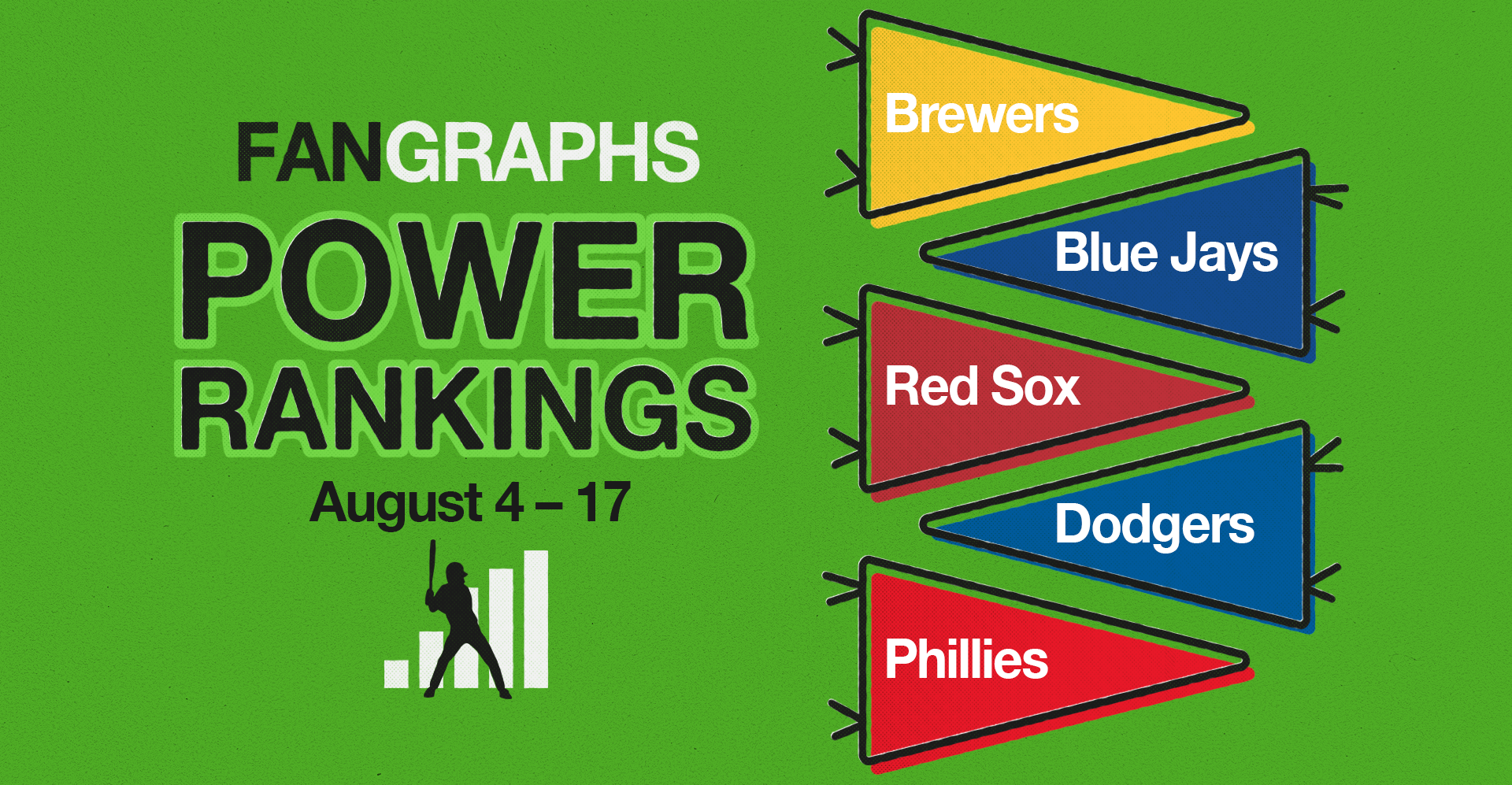
After a week hiatus, these power rankings are back… and nothing much has changed in the playoff picture. The National League is particularly stratified, even if the NL West is a bit closer than it was two weeks ago, and although there are a few more longshots in the American League, the 12-team field looks pretty settled right now.
Last year, we revamped our power rankings using a modified Elo rating system. If you’re familiar with chess rankings or FiveThirtyEight’s defunct sports section, you’ll know that Elo is an elegant solution that measures teams’ relative strength and is very reactive to recent performance. To avoid overweighting recent results during the season, we weigh each team’s raw Elo rank using our coin flip playoff odds (specifically, we regress the playoff odds by 50% and weigh those against the raw Elo ranking, increasing in weight as the season progresses to a maximum of 25%). The weighted Elo ranks are then displayed as “Power Score” in the tables below. As the best and worst teams sort themselves out throughout the season, they’ll filter to the top and bottom of the rankings, while the exercise will remain reactive to hot streaks or cold snaps.
First up are the full rankings, presented in a sortable table. Below that, I’ve grouped the teams into tiers with comments on a handful of clubs. You’ll notice that the official ordinal rankings don’t always match the tiers — there are times where I take editorial liberties when grouping teams together — but generally, the ordering is consistent. One thing to note: The playoff odds listed in the tables below are our standard Depth Charts odds, not the coin flip odds that are used in the ranking formula.
Complete Power Rankings
| Rank |
Team |
Record |
Elo |
Opponent Elo |
Playoff Odds |
Power Score |
Δ |
| 1 |
Brewers |
78-45 |
1644 |
1489 |
100.0% |
1664 |
0 |
| 2 |
Blue Jays |
73-52 |
1570 |
1499 |
99.5% |
1604 |
0 |
| 3 |
Red Sox |
68-57 |
1562 |
1501 |
78.8% |
1579 |
0 |
| 4 |
Dodgers |
71-53 |
1539 |
1504 |
99.8% |
1576 |
1 |
| 5 |
Phillies |
71-53 |
1539 |
1496 |
99.0% |
1576 |
1 |
| 6 |
Cubs |
70-53 |
1532 |
1509 |
97.9% |
1569 |
-2 |
| 7 |
Padres |
69-55 |
1537 |
1497 |
97.4% |
1568 |
0 |
| 8 |
Tigers |
73-53 |
1518 |
1487 |
99.3% |
1561 |
0 |
| 9 |
Mariners |
68-57 |
1539 |
1499 |
92.8% |
1560 |
2 |
| 10 |
Astros |
69-55 |
1527 |
1497 |
92.0% |
1558 |
0 |
| 11 |
Yankees |
67-57 |
1518 |
1504 |
93.5% |
1538 |
1 |
| 12 |
Reds |
65-60 |
1525 |
1499 |
14.3% |
1511 |
3 |
| 13 |
Mets |
66-58 |
1479 |
1493 |
85.9% |
1496 |
-4 |
| 14 |
Royals |
63-61 |
1523 |
1498 |
12.1% |
1493 |
2 |
| 15 |
Guardians |
63-60 |
1502 |
1497 |
14.7% |
1484 |
2 |
| 16 |
Orioles |
57-67 |
1509 |
1504 |
0.1% |
1460 |
2 |
| 17 |
Rangers |
62-63 |
1492 |
1501 |
11.6% |
1457 |
-3 |
| 18 |
Marlins |
59-65 |
1501 |
1507 |
0.3% |
1456 |
-5 |
| 19 |
Angels |
60-64 |
1490 |
1499 |
1.1% |
1449 |
0 |
| 20 |
Braves |
56-68 |
1495 |
1500 |
0.3% |
1448 |
8 |
| 21 |
Athletics |
56-70 |
1489 |
1504 |
0.0% |
1442 |
-1 |
| 22 |
Rays |
61-64 |
1469 |
1503 |
3.8% |
1432 |
1 |
| 23 |
Twins |
58-66 |
1464 |
1496 |
0.6% |
1424 |
2 |
| 24 |
Diamondbacks |
60-65 |
1456 |
1490 |
0.7% |
1420 |
2 |
| 25 |
Cardinals |
61-64 |
1451 |
1500 |
2.6% |
1418 |
-3 |
| 26 |
Pirates |
52-73 |
1454 |
1505 |
0.0% |
1415 |
-5 |
| 27 |
Giants |
60-64 |
1433 |
1493 |
1.8% |
1402 |
-3 |
| 28 |
Nationals |
50-74 |
1435 |
1509 |
0.0% |
1399 |
1 |
| 29 |
White Sox |
44-80 |
1414 |
1505 |
0.0% |
1383 |
-2 |
| 30 |
Rockies |
35-89 |
1394 |
1514 |
0.0% |
1367 |
0 |
…
Tier 1 – The Brewers
| Team |
Record |
Elo |
Opponent Elo |
Playoff Odds |
Power Score |
| Brewers |
78-45 |
1644 |
1489 |
100.0% |
1664 |
Well, the Brewers finally lost a game in the month of August. Their 14-game winning streak propelled their lead in the NL Central from one game ahead of the Cubs on July 31 to an eight-game gap, and they have the best record in the majors by six games. They’ve barely felt the impact of Jackson Chourio’s hamstring injury, which he suffered a few weeks ago, because nearly everyone else in their lineup is on fire. Seven of the eight Milwaukee players who have collected at least 50 plate appearances in August are running a 125 wRC+ or higher for the month. The Brew Crew will have an opportunity to truly bury the Cubs in the standings, as those two rivals have a five-game series on the schedule this week, beginning with a doubleheader on Monday at Wrigley Field.
Tier 2 – On the Cusp of Greatness
| Team |
Record |
Elo |
Opponent Elo |
Playoff Odds |
Power Score |
| Blue Jays |
73-52 |
1570 |
1499 |
99.5% |
1604 |
| Red Sox |
68-57 |
1562 |
1501 |
78.8% |
1579 |
| Dodgers |
71-53 |
1539 |
1504 |
99.8% |
1576 |
| Phillies |
71-53 |
1539 |
1496 |
99.0% |
1576 |
The Blue Jays extended their lead in the AL East to five games by going 4-2 last week against the Cubs and Rangers. They might not be the most complete team in the AL, but as long as their superstars are producing, they look very hard to beat. To wit: Vladimir Guerrero Jr. blasted his sixth home run of the month on Sunday, Bo Bichette has returned to form after his terrible 2024 season, and George Springer was just activated off the IL on Saturday.
It took him a few weeks to acclimate to the big leagues, but beginning with a 3-for-6 showing on June 28, Roman Anthony has slashed .322/.433/.409 (a 158 wRC+) in 40 games. And he’ll be anchoring this lineup for a long time to come, as Boston signed him to a huge extension a few weeks ago. After treading water in the Wild Card race with a 3-3 record last week, the Red Sox have a huge four-game series against the Yankees looming this weekend in the Bronx.
The Dodgers and Padres entered last weekend’s series in Los Angeles on very different trajectories. After suffering a sweep at the hands of the Angels, the Dodgers dropped from first place in the NL West for the first time since late April. Meanwhile, San Diego had been surging, winners of five straight series with a 14-3 record over its previous 17 games. Then, naturally, Los Angeles won all three games to flip the momentum of both teams. The Dodgers once again lead the division, by two games entering this week, but this race is far from over, despite our playoff odds giving the Padres just a 16.1% shot at winning the West. We’ll see how those odds move after the two teams match up for three games in San Diego this weekend in their final meeting of the regular season.
The Phillies extended their lead in the NL East from half a game on August 4 to five games entering Monday, but they are now facing the prolonged absence of Zack Wheeler, who was placed on the IL on Sunday with a blood clot in his shoulder. The returns of both Aaron Nola and Alec Bohm from their respective injuries should soften the blow a bit, and Philadelphia should have the rotation depth to get by without Wheeler in the regular season. However, it’s quite possible the Phillies won’t have their best pitcher back for October. That’s a major concern in what should be a very competitive NL postseason field.
Tier 3 – Solid Contenders
| Team |
Record |
Elo |
Opponent Elo |
Playoff Odds |
Power Score |
| Cubs |
70-53 |
1532 |
1509 |
97.9% |
1569 |
| Padres |
69-55 |
1537 |
1497 |
97.4% |
1568 |
| Tigers |
73-53 |
1518 |
1487 |
99.3% |
1561 |
| Mariners |
68-57 |
1539 |
1499 |
92.8% |
1560 |
| Astros |
69-55 |
1527 |
1497 |
92.0% |
1558 |
Even if the Cubs do well in their huge five-game set against the Brewers this week, it probably won’t be enough to disturb Milwaukee’s chances of winning the division. Instead, a good performance should allow Chicago to regain some of the momentum it has lost. When the Cubs took two out of three games from the Pirates over the weekend, it marked just the third time the North Siders have won a series in the four weeks since July 21, a span of eight series.
It looks like the Tigers have put their July swoon behind them. They couldn’t complete the four-game sweep of the Twins on Sunday, but they’ve now won three straight series and have gone 13-7 over their last 20 games. The Astros will visit Detroit this week in a showdown between two of the best teams in the AL.
The Mariners had an eight-game winning streak snapped on Wednesday, but their surge earned them a share of the AL West lead for a very brief moment. From there, though, Seattle faltered again, losing both of its series last week, against the Orioles and the Mets, and slipping to 1 1/2 games behind the Astros in the West. Even so, things are looking up for the Mariners: With Bryce Miller set to be activated off the IL on Tuesday, the M’s will have all five of their top starters active and healthy for the first time this season. Meanwhile, after a frigid three weeks coming out of the All-Star break, Cal Raleigh is on fire once again. Over his last nine games, Big Dumper is slashing .303/.395/.818 with five home runs and a 231 wRC+.
As for the Astros, you can chalk up another injury on their long ledger this season. This time it’s a shoulder injury to Josh Hader, which is expected to sideline him for the rest of the regular season, though the door is still slightly open for an October return if everything heals well. In better news, Yordan Alvarez is set to begin a minor league rehab assignment this week.
Tier 4 – The Melee
| Team |
Record |
Elo |
Opponent Elo |
Playoff Odds |
Power Score |
| Yankees |
67-57 |
1518 |
1504 |
93.5% |
1538 |
| Reds |
65-60 |
1525 |
1499 |
14.3% |
1511 |
| Mets |
66-58 |
1479 |
1493 |
85.9% |
1496 |
Since being activated from the IL on August 5, Aaron Judge has posted a very-mortal-though-still-solid .229/.426/.429 slash line (140 wRC+). No matter, the Yankees have gone 7-4 with Judge back in the lineup and have crawled back within a half game of the Red Sox and Mariners for the top Wild Card spot in the AL.
Things got pretty dicy for New York’s National League team, as the Mets slogged through a brutal 2-14 stretch and let the Reds close the gap considerably in the Wild Card standings. New York never let go of that final spot, and its back-to-back wins against the Mariners over the weekend provided a little bit of breathing room, but this is still a much tighter race than anyone in Queens would like. The good news for the Mets is that their two Franciscos in are heating up; Lindor tallied 14 hits and three home runs last week, and Alvarez has posted a .323/.408/.645 slash line (193 wRC+) since being recalled from Triple-A on July 21.
With the Mets stumbling, the Reds looked like they were poised to pull into a playoff position, especially after they won their series against the Phillies heading into last weekend. But Cincinnati ran into the Brewers at exactly the wrong time, losing the first two games before snapping Milwaukee’s 14-game winning streak in extra innings on Sunday. Unfortunately, as soon as the Reds activated Hunter Greene off the IL, Chase Burns switched places with him after suffering a flexor strain in his throwing elbow. For now, manager Terry Francona is hoping for the best-case scenario, that Burns can resume throwing soon and return before the end of August. However, Reds fans shouldn’t get too excited just yet, as the organization will surely be cautious with the 22-year-old’s rehab and almost certainly limit his workload the rest of the way.
Tier 5 – AL Longshots
| Team |
Record |
Elo |
Opponent Elo |
Playoff Odds |
Power Score |
| Royals |
63-61 |
1523 |
1498 |
12.1% |
1493 |
| Guardians |
63-60 |
1502 |
1497 |
14.7% |
1484 |
| Rangers |
62-63 |
1492 |
1501 |
11.6% |
1457 |
The three teams in this tier are desperately trying to hang on in the AL Wild Card race. The Guardians fell to 3 1/2 games behind the Yankees for the final playoff spot after getting swept by the Braves at home over the weekend. It was Cleveland’s first series loss since late July. Even with those three losses, the Guards still have the AL’s best record since July 7 (23-12). Meanwhile, the Royals have been nearly as good over that same span (20-13). Following a three-game sweep of White Sox, Kansas City enters this week just a half-game behind Cleveland in the standings.
On the other side of the coin, the Rangers are in the middle of what could be season-crushing skid. On July 27, Texas reached a season-best six games over .500; since then, the team has gone 6-13 and slipped below .500 again. This week probably represents the last gasp of hope for the Rangers to return to the Wild Card race. They travel to Kansas City for four games before hosting the Guardians for a three-game set this weekend.
Tier 6 – No Man’s Land
| Team |
Record |
Elo |
Opponent Elo |
Playoff Odds |
Power Score |
| Orioles |
57-67 |
1509 |
1504 |
0.1% |
1460 |
| Marlins |
59-65 |
1501 |
1507 |
0.3% |
1456 |
| Angels |
60-64 |
1490 |
1499 |
1.1% |
1449 |
| Braves |
56-68 |
1495 |
1500 |
0.3% |
1448 |
| Athletics |
56-70 |
1489 |
1504 |
0.0% |
1442 |
| Rays |
61-64 |
1469 |
1503 |
3.8% |
1432 |
It was fun while it lasted, but you can probably stick a fork in any hope of a surprise Wild Card run from the Marlins. After sweeping the Yankees three weekends ago to reach .500, they’ve won just four of their last 14 and are now seven games behind the Mets for the final playoff spot. To make matters worse, Kyle Stowers, Miami’s best hitter this season, was just placed on the IL with an oblique strain. At least the Marlins can point to their competitive stretch in July and dream about returning to contention sooner rather than later.
It’s far too little, too late, but the Braves are finally on a roll. They swept the Guardians last weekend and are now 9-2 over their last 11 games. The key to this late-season surge has been the resurgence of Michael Harris II. After making some swing adjustments in early July, he’s slashing .386/.402/.719 (210 wRC+) since the All-Star break. If Atlanta doesn’t have to worry about Harris’ bat moving forward, it gives the organization one less thing to address in what has suddenly become a hugely important offseason.
Not to discount what Harris has done lately, but the two best hitters in baseball during the second half of the season both play for the Athletics. You probably know about the heater that Nick Kurtz is on, but Shea Langeliers has been almost as good over the last month. Both of those guys blasted home runs on Sunday — for Langeliers, it was his major league-leading 14th since the All-Star break. The A’s will need to figure out how to pitch in their temporary home in Sacramento, but their offense certainly looks like it’s for real.
Tier 7 – Worst-Case Scenarios
| Team |
Record |
Elo |
Opponent Elo |
Playoff Odds |
Power Score |
| Twins |
58-66 |
1464 |
1496 |
0.6% |
1424 |
| Diamondbacks |
60-65 |
1456 |
1490 |
0.7% |
1420 |
| Cardinals |
61-64 |
1451 |
1500 |
2.6% |
1418 |
| Pirates |
52-73 |
1454 |
1505 |
0.0% |
1415 |
| Giants |
60-64 |
1433 |
1493 |
1.8% |
1402 |
The Twins’ expected post-deadline crash hasn’t exactly arrived. Sure, they went 2-5 against the Yankees and Tigers last week, but they are only a game below .500 since they sold nearly every spare part off their roster. The fantastic play of Luke Keaschall is a big reason why they’re still playing like a competitive team; he’s posted a 149 wRC+ since being activated off the IL on August 5. The biggest baseball news in Minnesota last week was the announcement that the Pohlad family will remain principal owners of the team after exploring a sale. The optics of this announcement stink. The Twins just traded away a huge chunk of the roster and dumped Carlos Correa off the payroll. To turn around and say this teardown was “part of the process” looks like an extension of the same penny pinching that led to these past two disappointing seasons. The hope established in 2023, when they won their first playoff series in two decades, feels like a long, long time ago.
Tier 8 – Hope Deferred
| Team |
Record |
Elo |
Opponent Elo |
Playoff Odds |
Power Score |
| Nationals |
50-74 |
1435 |
1509 |
0.0% |
1399 |
| White Sox |
44-80 |
1414 |
1505 |
0.0% |
1383 |
| Rockies |
35-89 |
1394 |
1514 |
0.0% |
1367 |
With a pair of series wins over the Cardinals and Diamondbacks last week, the Rockies are now playing ahead of the historically bad pace of the 2024 White Sox. Colorado has to win just seven games before the end of the season to avoid tying Chicago’s record of futility. That certainly feels doable, even if the Rockies have one of the most difficult remaining schedules in baseball.


